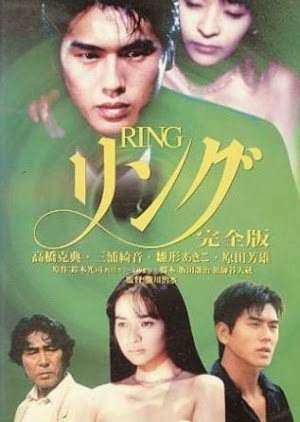 The true inception of the phenomenally popular RING film cycle was this Japanese TV movie from 1995. It has no direct connection to any of the other RING films (outside the presence of screenwriter Jôji Iida, who would go on to script and direct the 1998 SPIRAL) and, truth be told, will never supplant the masterful RINGU from 1998, nor the 1999 Korean language remake THE RING VIRUS, or even the American-made RING from 2002. RING KANZENBAN is, however, the most faithful adaptation to date of Koji Suzuki’s 1991 Japanese language source novel RING—and that novel (translated into English in 2003) is one of the decade’s finest horror stories. The story, as conceived by Suzuki (but altered in most of the films), has also taken on a new relevance in the Covid age, given that it involves a distinctly plague-like curse spread by a videotape.
The true inception of the phenomenally popular RING film cycle was this Japanese TV movie from 1995. It has no direct connection to any of the other RING films (outside the presence of screenwriter Jôji Iida, who would go on to script and direct the 1998 SPIRAL) and, truth be told, will never supplant the masterful RINGU from 1998, nor the 1999 Korean language remake THE RING VIRUS, or even the American-made RING from 2002. RING KANZENBAN is, however, the most faithful adaptation to date of Koji Suzuki’s 1991 Japanese language source novel RING—and that novel (translated into English in 2003) is one of the decade’s finest horror stories. The story, as conceived by Suzuki (but altered in most of the films), has also taken on a new relevance in the Covid age, given that it involves a distinctly plague-like curse spread by a videotape.
The differences between this RING and those that followed start with the gender of the main character Asakawa, a male reporter (a woman in the later RINGS) investigating the inexplicable deaths of four outwardly healthy teenagers. You probably already know the rest of the details: a resort cabin where all the teens congregated contains a VHS tape depicting a succession of strange sights capped with an onscreen warning: “You who saw these images have seven days left.” Asakawa’s pal Takayama, an eccentric college professor, views the tape and concludes that the images on it, broken up with odd cuts to black that are apparently eye blinks (another element that didn’t make it into subsequent RINGS), are actually psychically imprinted memories by a young woman (as opposed to the hag of the later films) named Sadako, who happens to be the late daughter of a renowned clairvoyant.
Sadako, we learn, was more psychically gifted than her father, and ended her life by being thrown into a well by a jilted lover. Asakawa and Takayama decide to track down Sadako’s remains and give them a proper burial, which they hope will end the curse—but that, as I’m sure you’re well aware, is not how things work out.
What’s missing here is the RING films’ iconic woman-emerging-from-a-television set image (although of course that sight wasn’t in the Suzuki novel, either). It does, however, contain an audacious fourth wall-breaking post-end credits sequence in which the imagery on the accursed videotape is shown once again to the viewer, suggesting that s/he has been cursed like the characters in the film.
That this was a nineties made-for-television product is evident in all the hoary TV movie elements that recur throughout RING KANZENBAN, starting with the tacky broadcast video photography and continuing with the overwrought tone and distractingly histrionic performances. It also loses focus in places, as in the opening SCREAM-like shower death and wholly gratuitous female nudity (Japanese television evidently has far more liberal censorship standards than our own) that pops up throughout.
But the ingenuity of Suzuki’s narrative shines through, making for a crisp plot-based thriller that compels in spite of its shortcomings. This means that for non-Japanese speakers English subtitles (provided initially by the late greymarket VHS outfit Video Search of Miami, and later via online “Fansubs”) are a must.
Vital Statistics
RINGU: KANZENBAN
Fuji Television Network
Director: Chisui Takigawa
Producers: Hidehiro Iwadera, Noriyasu Ueki
Screenplay: Jôji Iida, Taizô Soshigaya
(Based on a novel by Koji Suzuki)
Cinematography: Kazumi Iwata
Editing: Ichiro Chaen
Cast: Katsunori Takahashi, Ayane Miura, Mai Tachihara, Maha Hamada, Tomorô Taguchi, Akiko Hinagata, Takayuki Godai, Shigeyuki Nakamura, Akira Sakamoto, Aya Mizuno, Kyôko Dônowaki, Kikuko Hashimoto, Akira Senô, Yuka Takeshima
